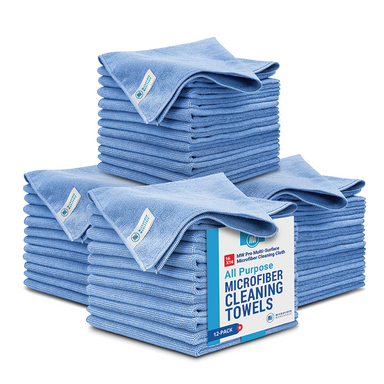So now that you know how microfiber works and how it can increase cleanliness while saving money and energy, let’s help you identify the scammers and pick the best value microfiber for your dollar. There are swindlers on both the upper and lower ends of the microfiber market, so don’t think buying pricey products will save you!
Like Goldilocks and the Three Bears, you will find that some microfiber is too cheap, others too exploitative, while the good ones are just right. Let’s expose their lies one at a time.
First is the Bargain Basement Barkers, who pretend that microfiber is a commodity like sugar, saying that every towel performs the same, so you should just buy the lowest price. This is patently false.
Every microfiber cloth has different amounts of microfiber woven in, making it more or less densely packed. This density is measured in grams per square inch (gsm).
Quality microfiber towels like Microfiber Wholesale have ~330gsm, while economy brands often have as little as 200gsm, which is 50% less microfiber! That means 50% less dirt grabbing and labor savings, but that’s not even the worst of it.
The biggest trick of cheap microfiber is inferior, unshredded fibers. As already mentioned, split-strand shredded fibers are what give microfiber its best superpowers, increasing absorption, reducing dry time, creating friction, and making static electricity to attract and trap dirt.
Unscrupulous companies use unshredded fibers because it’s way cheaper, and they’re counting on their customers not knowing why shredding matters! Poor dupes are basically cleaning with an over-glorified polyester shirt and wondering why microfiber doesn’t work as well as everyone promised. It’s awful.
On the flip side are the Half-Science Hucksters, making wild claims through the power of lies of omission to convince innocent people to pay WAY more than they should for towels that really do half of what they promised.
The biggest lie of omission you’ll see in this group is implying features that are common to all microfiber are exclusive to their products.
They’ll brag about their towels picking up 99.5% of dirt and bacteria as if it were a new advancement they alone achieved when it’s actually true of all good quality split-strand microfiber. By implying it’s a feature unique to them, they can falsely justify charging 10x more per towel than competitors that do the exact same thing! It’s dastardly, but it’s not half as bad as their worst lie.
The most unscrupulous microfiber lie from Half-Science Hucksters is their false promises of germ-killing towels powered by the magical properties of silver ions. These companies, through carefully selected vague wording, let customers and their own salespeople falsely believe for YEARS that their magical towels woven with silver could kill germs on surfaces as you cleaned with them.
In reality, silver ions can kill germs, BUT only if they make direct continuous contact with the bacteria for several hours! Germs that land in between ions or were hidden inside small globs of organic matter inside the towel were unaffected.
This means that the silver ions did zippitydooda to improve microfiber’s germ-killing abilities while cleaning surfaces, and at most, it just helped kill some extra bacteria in the dirty towels when they were left out to dry.
This lie wasn’t just sneaky. It was downright dangerous, as swindled customers used their overpriced dirty towels over and over based on false assurances of germ control until they got themselves sick! It wasn’t till the pandemic that these types of companies were forced to more accurately word their claims so as to keep their customers from trying to fight a deadly disease with a towel that had nothing more than an overpriced odor control treatment.

















